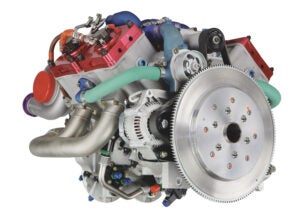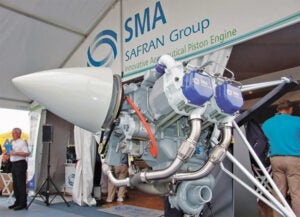
For an engine long on the verge of viability but never quite making it over the threshold, the DeltaHawk is looking ever more real. It received FAA certification and the company will be pursuing firewall-forward packages for both production and Experimental aircraft. Perhaps more important was the late-in-the-year announcement that up-powered versions of the DHK180 are being developed.
Two new variations of the 202- cubic-inch two-stroke diesel are planned: one with 200 hp and the other with 235. I’m told that fuel system changes and different turbochargers are responsible, meaning that the company is adding boost to get power. There are no internal changes as the DHK180 was “very conservatively designed” and didn’t need any. The subtext here is that it was built to grow, which from a marketing standpoint is wise even if the lower-power engine is carrying some heft it doesn’t otherwise need.
The higher-spec DHK moves the power-to-weight numbers closer to the four-cylinder Lycoming IO-390, though it’s still short. The DeltaHawk is nearly 50 pounds heavier but at 235 hp will bring more power to the party and has the added benefit of turbocharging to make that power hold on at altitude. Its fuel specifics are good but not mind-blowingly so. I’ll be curious to see what the actual, ready-to-fly weights will be.

Another Player
More than a decade ago, there was a push in GA toward piston diesels. One of the key players was SMA, which fielded an air-cooled, opposed-four-cylinder engine with turbocharging and FADEC. The engine was never offered for Experimentals, even though the SR305 made good power—both 230-hp and 260-hp versions were available. But the all-up weight of 455 pounds was still more than even a six-cylinder Lycoming.
Now the SR305 has new owners: SMA Aero Engines GmbH in Egelsbach, Germany. They’re taking a different approach from the previous owners and, for that matter, from Continental and its piston diesel. That is, the previous SMA, like the Continental, was only available as an OEM contract, not directly to builders. This means you absolutely need a factory-engineered FWF package and layers of support, which is smart from the engine maker’s side but greatly restricts the potential market; not many kit manufacturers have the capital to engineer FWF packages beyond those they know will sell well. The hope is that the new company will relax some of those restrictions and make the engine available to builders. We’re due to have a long conversation this summer at AirVenture about the SR305 and the company’s plans.
Tipping Point?
I’ve predicted various tipping points in our industry before, with a batting average somewhat above the Mendoza line but well short of all-star quality, so I’ll be careful here. But I do think we have a series of converging events that might, just might, give Jet A-burning engines another shot. It starts with our agonizing crawl toward an unleaded avgas that can be used across the board—autogas and 94-octane unleaded won’t do it. It’s a dreadful turn of events that our industry is still grappling with under the EAGLE initiative even as General Aviation Modifications Incorporated (GAMI) already has an FAA-approved (via STC) replacement for 100LL. Even in the best case, GAMI’s G100UL will be more expensive than 100LL, further opening the gap to Jet A. There’s nothing to say that any of the potential candidates through the EAGLE program (when/if they arrive by 2030) will fare any better. And the bummer parade continues through the huge increase in the prices of new piston engines and production delays.
As Tom Wilson says in his column, “Case for the Lyconsaur,” there are a lot of things our legacy engines do well. And our decades of knowing how they break and how to build them shouldn’t be shortchanged. But those benefits are falling out of proportion to the prices asked for them and, frankly, for the broad perception among the builder community that we’re now paying way too much for powerplants whose engineering was long-ago amortized.
Van’s Makes Progress
In mid-February, Van’s Aircraft posted a brief video providing some good news on the company’s recovery. As previously mentioned, Van’s unilaterally canceled purchase agreements and raised prices on kits. Builders could either agree to the new price or have whatever deposits they’d made land among the claims that the company intended to pay back eventually. At the time, Van’s said it was aiming for a 70% reorder rate, meaning that they expected a bit less than a third of the builders to reject the offer and, for a time, lose their deposits. In February, Van’s announced that its “overall” reorder rate was 81% (for kits and third-party items) and that the reorder rate for kits alone was 78%.
Without having the complete picture, it’s hard to know what that looks like in detail. But it is likely that builders who had just begun the process and had a relatively small deposit on order are more likely to not reorder while those with substantial investments have significantly more incentive to pay the increased prices so they can finish their airplanes. If all you’re waiting for is the firewall-forward kit, for example, you’re kind of in a bind.
And that explains another piece of information from the announcement: Reorders on engines are running at 93% with a few days still to go before the take-it-or-leave-it deadline. In late January, Van’s announced that it would be able to honor orders for various third-party components, including Lycoming engines and Hartzell propellers, albeit with price increases. For the engines, the upcharge was 12% or the slightly increased 2024 prices, whichever was lower. Hartzell prop prices increased by 3%. While still a bitter pill, the news that most builders’ deposits had been largely preserved was a relief. With base Lycoming engines (not the high-end Thunderbolt versions) starting at just under $40,000 and extending to just shy of $70,000 for a parallel-valve IO-540, that deposit is not a small number for most builders.
Because we still operate as though engines were readily available—long delays and constantly shifting delivery dates prove otherwise—many builders wait until late in the process to order engines. So it makes sense that a higher percentage of late-stage builders (shall we say) are sufficiently committed that they’ll stay on the program.
There are important takeaways here. First is that Van’s has sufficient builder support to be economically viable for the short term, while its new management structure guides it through the Chapter 11 reorganization, at least. (The reorg plan was due to be filed in early March.) Second is that this is going to be a long-term recovery. Van’s has to get its production back in order, get its enterprise resource planning (ERP) system in place and, finally, continue to produce parts for builders who want to replace laser-cut parts in their kits. By early February, Van’s had produced enough parts for roughly 9% of the affected kits. Progress, slow and painful to be sure, but progress nevertheless.














Being in Europe I would love a JetA1 burning engine, But it has to be cost effective.
And there’s the rub, Jonathan. It very likely won’t be cost effective, though the fuel it burns certainly is.
It is a bit heavier that the Continental I now fly behind. But, for the reliability and lower fuel cost, [ use #2 diesel from the local gas station ], I’ll gladly add ballast to the tail to get the CG back.
The diesel has no carburetor or throttle, no magnetos/ignition system, no cam or valve system, and the super/turbochargers will greatly improve the high density performance, with flying in the high Sierra airports.
I have two diesel agricultural machines that have been running trouble free for 30 years. The most important thing is to keep the fuel clean, since a small piece of grit can prevent the fuel injection unit from operating properly. [ ask me how I know ?! ].
Gone are the days when diesels were the only fuel injected engines. Keeping fuel clean applies to all fuel types as virtually every engine is fuel injected these days
Compare an RV14 with Lycoming IO390 / 215 hp vs DeltaHawk DHK 200 hp:
At 3000 msl they both produce 200 hp at full throttle. Above 3000 msl the DHK 200 has more hp than the non-turbocharged Lycoming. Which would you rather have?